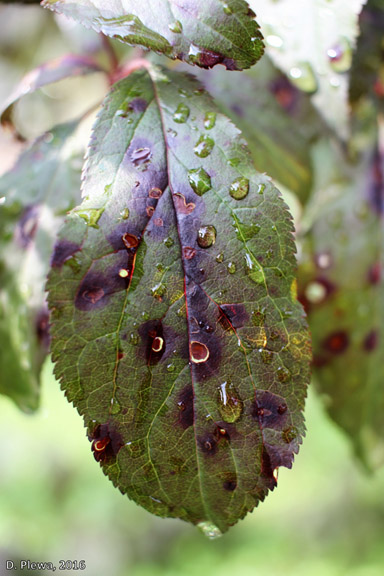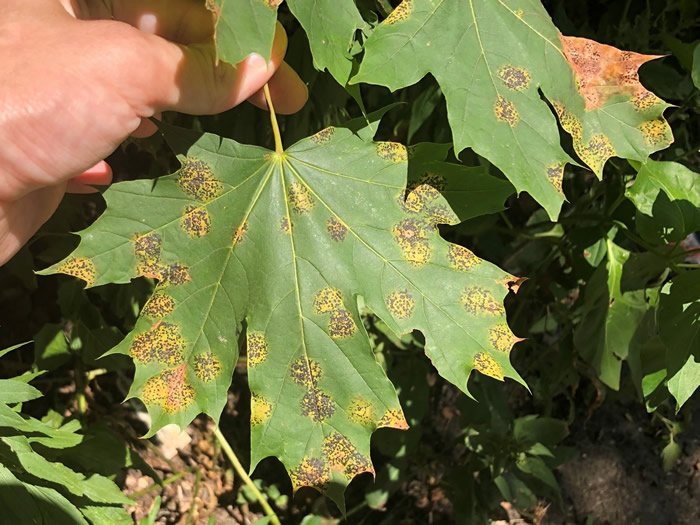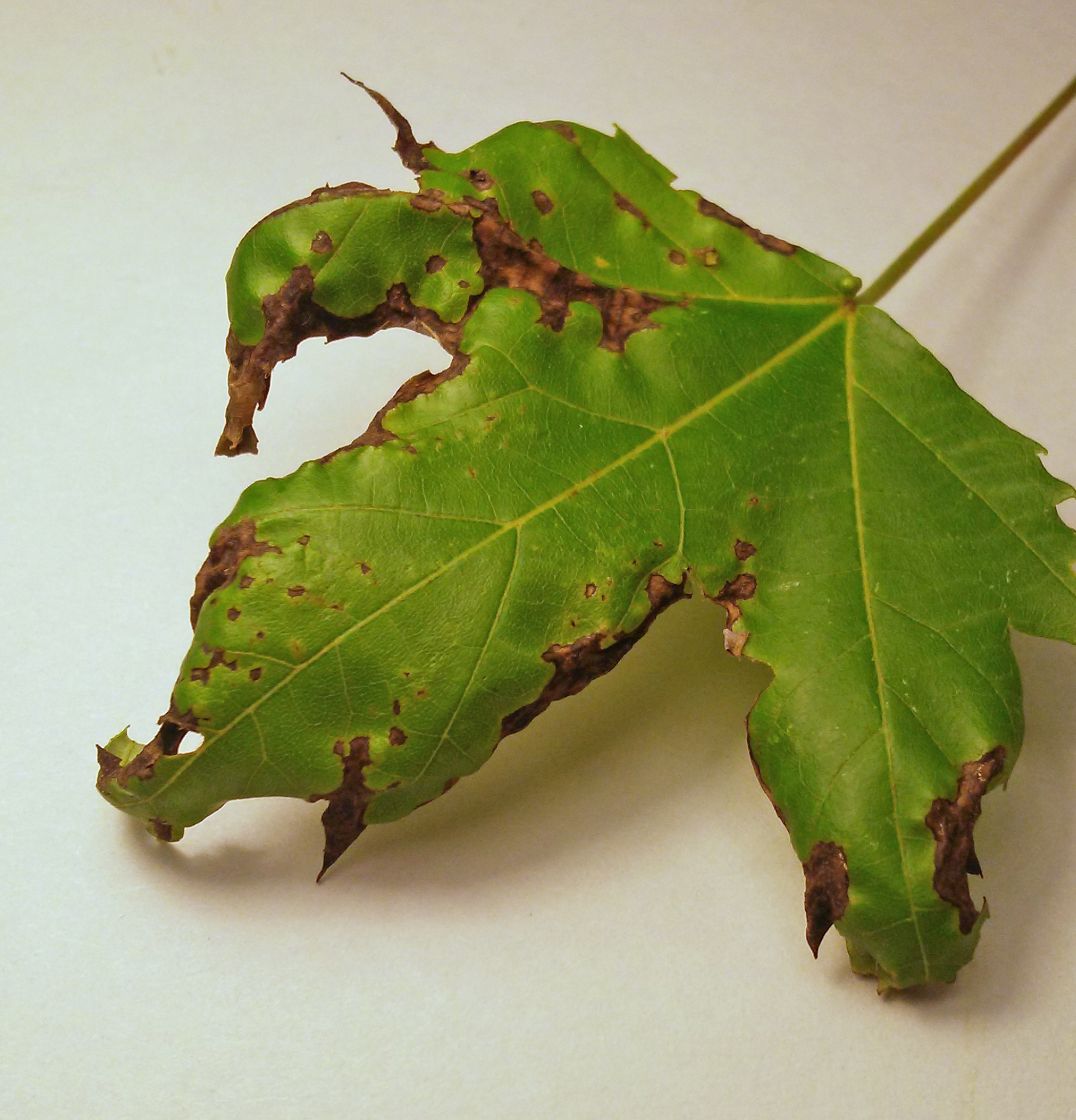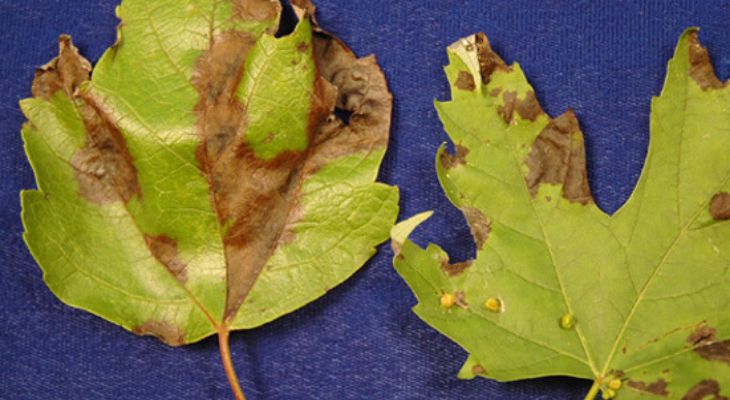black spots on tree leaves in illinois
Infected leaves sometimes drop. Ash Oak Sycamore Maple and Birch are a few of the tree species commonly affected by Anthracnose.

Home Yard Garden Newsletter At The University Of Illinois
Box elder Norway maple Oregon maple Red maple Silver maple Sugar maple Sycamore As with most tree fungi maple tar is more likely to happen if your area has been getting lots of rain.
. The symptoms initially appear in mid-June as small pale yellow spots. Leaf spot diseases should be taken seriously if they result in moderate to complete leaf loss two to four years in a row. Anthracnose is a common disease among deciduous trees especially sycamore ash and oak.
It also affects shrubs such as privet. Leaf spot diseases weaken trees and shrubs by interrupting photosynthesis. This peach tree leaf spot disease is caused by the bacterium Xanthomonas campestris pv.
If you take a close look at the trees in your yard you may notice signs such as black spots on the leaves. Black spot is caused by a fungus called Diplocarpon rosae which overwinters on infected leaves. The following are some of the common symptoms indicating that your tree is infected.
Phyllosticta leaf spot of maple image by Joan Allen. Maple leaves are quite common in Toronto. Sooty splotch can also be brown but the color will be darker and it can also be black.
In Illinois we may see three foliar diseases of dogwood. A large quantity of leaves with brown to black spots and blotches may have fallen from infected trees this spring. The first two cause aesthetic problems but Discula anthracnose can kill branches and even entire trees.
Theyre all called tar spot and they most often affect. Cherry The cherry tree is probably best known for its beautiful springtime blooms. The first symptoms are seen in the early summer as small yellow spots less than 18 of an inch in diameter.
Most leaf spot diseases affect only a small percentage of the trees overall leaf area and are a minor stress on the health of the tree. Please contact Plant Information Service at 847 835-0972 or email Click here to show mail address for a positive diagnosis and if you feel chemical treatment options are warranted. This allows the oak tree to photosynthesize and turn sunlight into energy for processing nutrients and moving water throughout the structure of the branches trunk and roots.
In general the leaf spot fungi are favored by cool wet weather early in the growing season. The smudges are generally half an inch or larger and appear on the fruit. Anthracnose is a fungal disease that affects many types of deciduous trees.
Leaf spot diseases are seldom a problem following warm dry weather in the spring. However you may notice that the leaves have some brown or black spots in summer. Leaves infected with Anthracnose are often spotty especially along the veins and with brown curled edges.
Black Tar Spot on Sugar Maple Most commonly this list includes verticillium wilt also referred to as maple wilt anthracnose and tar spot. Bacterial spot on peach trees results in loss of fruit and the overall malaise of trees caused by recurrent defoliation. This is another tree that could liven up your landscape but may also be host to several diseases.
Black leaf spot of American elm. Live oak leaves should be flat dark green and healthy. In spring microscopic spores are released which are airborne.
Black spots on oak leaves probably indicate a fungal problem. The spots may also show a pattern of wavy indentations or ripples. There are a couple types of fungi that cause those big brown or black spots on maple trees.
By the end of August the spots closely resemble a drop of tar. All are fungal diseases. Both are also fungal diseases.
Diseased spots are raised rough and scablike IL Nat. It causes unsightly dark sunken lesions on leaves stems flowers and fruits. By mid-July the yellow spots expand and a thick raised black stomata starts to form.
Does not seriously affe ct the health of a tree. The fungal spores enter the leaf tissue and as they reproduce they cause the black spots. Apple scab is a fungal disease.
Fortunately we do not see Discula anthracnose often. Anthracnose fungi need water to spread and infect so the disease is more prevalent during wet cold springs. Certain leaf spots have special names such as anthra cnose black spot downy spot or white mold ink spot spot anthracnose leaf blister or curl scab shot-hole.
Septoria leaf spot spot anthracnose and Discula anthracnose. All commonly grown trees and shrubs are subject to attack by one or more leaf infecting fungi. Irregular dead spots on leaves Formation of cankers on twigs branches and the trunk Wilting and blackening of affected foliage Premature leaf drop Bud death resembling frost damage.
They will feed on young leaves and buds contributing to defoliation of the tree. Because maple leaf tar spot is primarily a cosmetic disease fungicide treatments are usually not necessary. The wind carries them over a distance and some of them land on maple tree leaves.
If the spots look more like black spots or blotches this could be flyspeck or sooty splotch on apples. This late-summer fungal disease is caused by fungi in the genus Rhytisma that is easily identified by its raised black spots to develop on the upper surfaces of affected leaves. In the spring especially in areas of high humidity and rain the fungal spores are splashed on to new leaves and begin their infection cycle.
As the season progresses a black spot develops within the yellow tissue and enlarges in size and thickness. These caterpillars are dark in color with brightly colored stripes and hairs and they often feed and live in groups. Tent caterpillars are social colorful caterpillars that feed on leaves of broad-leafed trees and build silk tents on the leaves and branches.
Probably the most dramatic leaf spotting and leaf drop we see in Illinois from anthracnose is on ash sycamore and walnut. The sticky spores open up and start colonizing the leaf and the imbalance resulting from this causes the maple leaves to form yellow and then black spots. With warmer weather and rain the trees will produce a new flush of leaves and recover.
Bacterial leaf spot of peach also known as bacterial shot hole is a common disease on older peach trees and nectarines. The leaves will appear green in spring and then change color to a beautiful yellow orange and red in fall.

Unsightly Black Spot On Maple Leaves Will Not Harm Trees Riverbender Com

Unsightly Black Spots On Maple Leaves Won T Harm Trees Dupage County Farm Bureau

Anthracnose Of Shade Trees The Morton Arboretum
Anthracnose Tar Spots On Trees City Of Blue Island

Host Plant Genetic Control Of Associated Fungal And Insect Species In A Populus Hybrid Cross Simon 2020 Ecology And Evolution Wiley Online Library

Maple Tree Diseases Lovetoknow
My Leaves Have These Weird Bumps And Lumps On Them Arborsmith Ltd Crafstman In The Care Of Trees

Maple Tar Spot Identification Prevention Treatment Faqs For Northeast Ohio Independent Tree
Anthracnose Tar Spots On Trees City Of Blue Island

Sick Oak Leaves Serious Or Superficial News

Home Yard Garden Newsletter At The University Of Illinois

Denis Ryabtsun Dryabsinthe Instagram Photos And Videos Plant Leaves Plants Instagram

Too Much Moisture More Tree Problems University Of Illinois Extension

